JOINTISZA - Making the most of cooperation
06-11-2017
Four projects, including JOINTISZA, discuss synergy-building opportunities at capitalisation event during recent Danube Forum in Budapest
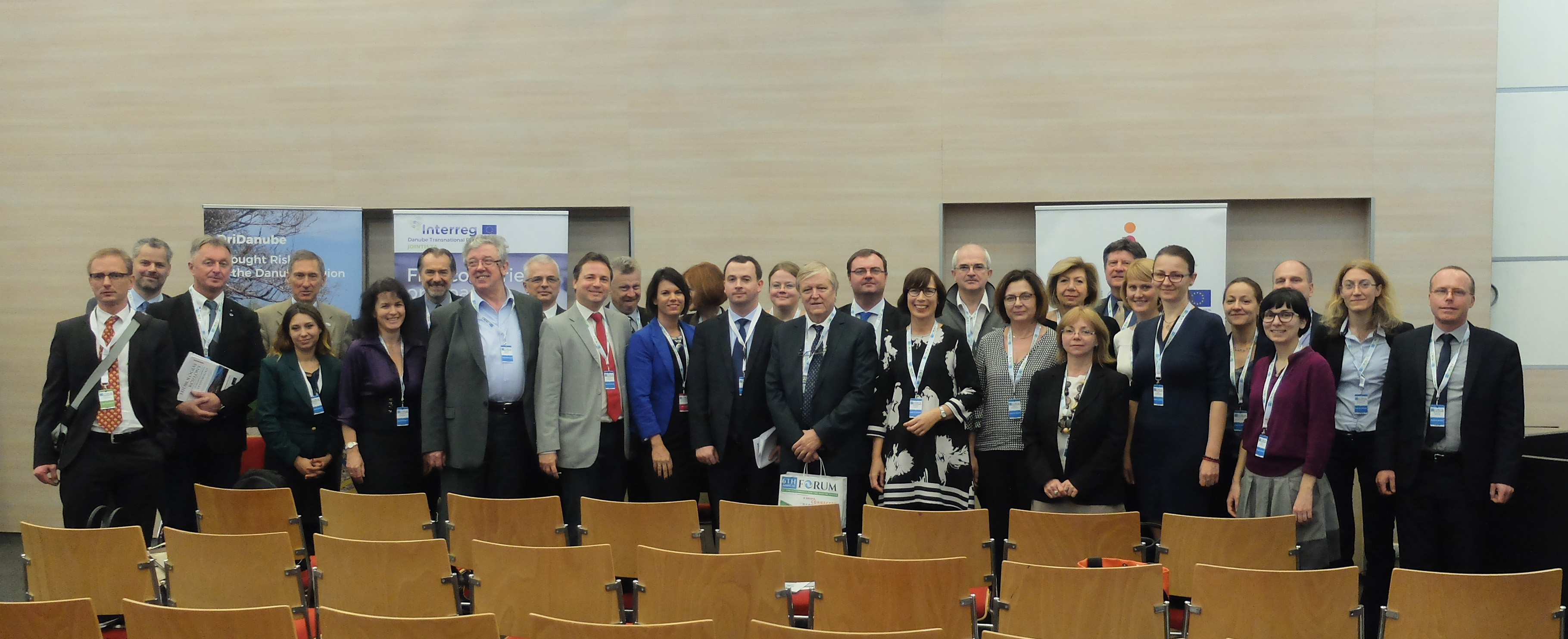
Representatives from four Interreg projects (CAMARO-D, DanubeSediment, DriDanube, and JOINTISZA) cooperating in the framework of Thematic Pole 4 in connection to water management, took part in a Danube Transnational Programme capitalisation event on October 19, 2017, during the 6th Annual Forum of the EU Strategy for the Danube Region, held in Budapest. The capitalisation event was streamed live on Facebook.
While each of the four projects focuses on a specific aspect of water management, the purpose of the event was to explore ways that the projects can get improved results through cooperation, collaboration, and sharing of information and expertise with the other project stakeholders. The event was moderated by Balazs Horvath from the General Directorate of Water Management, Hungary, and Coordinator for EUSDR Priority Area 4.
Participating in the capitalisation event as project representatives were: Hubert Siegel from the Austrian Federal Ministry of Agriculture, Forestry, Water Management and Environment, the lead partner of the CAMARO-D project; Peter Bakonyi from the Technical University of Budapest, lead partner of the DanubeSediment project; Andreja Susnik from the Slovenian Environment Agency, representing the DriDanube project; and Gyorgy Ratfai from the Tisza Office of Szolnok, Hungary, and the General Directorate of Water Management, the lead partner of the JOINTISZA project.
Each of the participants was given the opportunity to introduce their project and describe main outputs, after which they shared possible and existing synergies with the other projects. Each of the projects started in 2017 and will run through mid-2019.
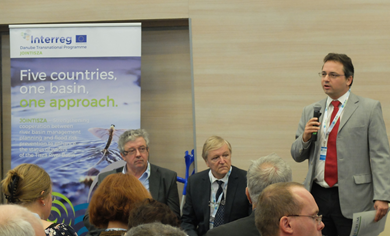 “What we’re trying to do with the Danube Strategy is to set up international projects that help in the implementation of river basin management plans, flood risk management plans and all related issues in a transboundary context,” Horvath said during his introduction.
“What we’re trying to do with the Danube Strategy is to set up international projects that help in the implementation of river basin management plans, flood risk management plans and all related issues in a transboundary context,” Horvath said during his introduction.
“Land use, the focus of the CAMARO-D project, is a crucial issue when you talk about water management, but another is movement of sediment in rivers—and the DanubeSediment project can assist in identifying common methodologies,” Horvath continued. “Problems also arise when there is too little water, which is what the DriDanube project addresses, but here we move to a more integrated project—JOINTISZA—which involves five countries in drafting an integrated river basin management plan.”
Components and combinations
CAMARO-D
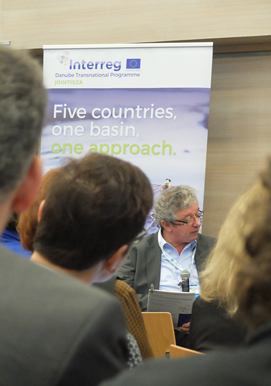 The CAMARO-D project has “partners from nine countries,” Hubert Siegel explained, “including governmental bodies, environmental agencies, water suppliers, and educational and research institutes. Our goal is not only to improve land use practices, but to also protect against floods.”
The CAMARO-D project has “partners from nine countries,” Hubert Siegel explained, “including governmental bodies, environmental agencies, water suppliers, and educational and research institutes. Our goal is not only to improve land use practices, but to also protect against floods.”
According to Siegel, the main outputs of CAMARO-D will be: a catchment-based land use development plan that will cover the whole area of the Danube basin; a decision support tool to help structure competences and facilitate acceptance of the land use development plan; and a roadmap for necessary steps and legislative concretisation at the national level of partner countries to improve land use management and organisational structure regarding water protection and flood protection.
A mid-term conference, planned for mid-2018, will involve JOINTISZA participants, as well as project partners EISDR, ICPDR and the Global Water Partnership. In spring 2019, the project will hold trainings in pilot areas dealing with interdependencies between land use, vegetation cover, groundwater resources, rivers and other areas, and will invite other pole project partners to share their new know-how. The main task of the project’s final conference will be to create an institutional, transnational Danube Region Platform to establish partnerships beyond the project lifetimes. Finally, the CAMARO-D project functions as an associated strategic partner of the DriDanube project through its cooperation with the Technical University of Vienna in model generation.
DanubeSediment
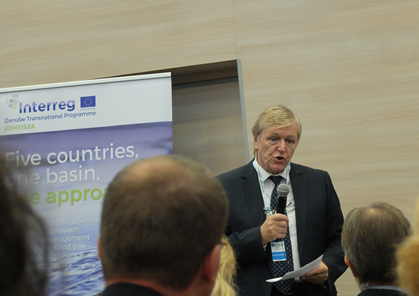 “In the Danube basin, there is an increasing discrepancy between sediment surpluses—that is, sedimentation of reservoirs—and sediment deficits—that is, coastal erosion,” said Peter Bakonyi. “An approach to deal with this issue needs to cover the whole river because sedimentation knows no administrative borders.”
“In the Danube basin, there is an increasing discrepancy between sediment surpluses—that is, sedimentation of reservoirs—and sediment deficits—that is, coastal erosion,” said Peter Bakonyi. “An approach to deal with this issue needs to cover the whole river because sedimentation knows no administrative borders.”
Bakonyi recalled that the DanubeSediment project was started because ICPDR experts recognised the lack of relevant knowledge during the preparation of the first and second versions of the Danube River Basin Management Plan. The DanubeSediment project aims to improve sediment management and restore sediment balance along the Danube.
Main outputs will include: a “Danube Sediment Management Guide”, including measures to be implemented; sediment manuals for stakeholders; and provision of means and tools to implement recommended measures. Sustainable sediment management will improve navigability, improve ecological conditions, contribute to sustainable hydropower, and help reduce flood risk in the region, Bakonyi said.
As for inter-project collaboration, while “sediment is just one slice of water management, our input on floods can be used in the other three projects,” he claimed. “Regarding the JOINTISZA project, our outputs can be directly used in the Integrated Tisza River Basin Management Plan. With the CAMARO-D project, land use and planning technology will influence runoff from the river basin and will influence the input of sediment into the river—clear grounds for collaboration. Regarding the DriDanube project, while the connection is not so obvious, dry periods have an impact on levels of sedimentation, so there is a natural link where we can combine our efforts in developing our projects.”
DriDanube
 “The DriDanube project deals with drought in the Danube region,” Andreja Susnik began, “and we would like to increase the preparedness of society to deal with drought. We have developed three main parts of this project.”
“The DriDanube project deals with drought in the Danube region,” Andreja Susnik began, “and we would like to increase the preparedness of society to deal with drought. We have developed three main parts of this project.”
The first, Susnik explained, is to harmonise drought monitoring throughout the region through what is called a ‘drought user service’. The service will mainly use remote sensing data, indexes and other tools available in the participating countries. Susnik said that second part of the project involves establishing a common monitoring approach to better understand where the region is most vulnerable. Finally, the project aims to establish a sort of innovative and harmonised strategy for drought management.
“Unlike other types of natural disasters, drought is a creeping phenomenon,” said Susnik. “It approaches slowly, and social perception of drought is slow as well. We would like to encourage countries to communicate, and to be in a proactive and not a reactive mode.”
As for cooperation, “the institutions that we are dealing with involve many of the same people,” Susnik pointed out. “So many of these stakeholders have overlapping concerns.”
Susnik mentioned that the DriDanube project is involved in two pilot projects—one in Serbia, a non-EU country, and another in Hungary, working together with JOINTISZA. “In carrying out the projects separately and differently, we believe that the quality of the final outputs and their sustainability will be higher,” explained.
Speaking in terms of the larger context of the Danube Forum, Susnik stressed that water management is not just about floods, drought or sediment, but also about many things that impact the water cycle and society. “Coordinated approaches will produce information, tools and methodologies that are more useful in practice,” she said. “We will profit for sure from capitalisation.”
JOINTISZA
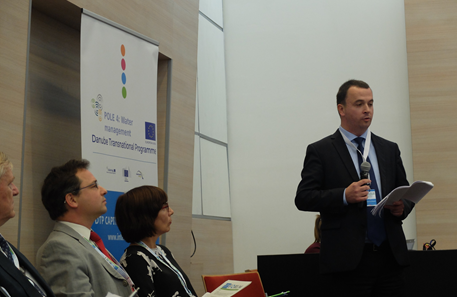 The JOINTISZA project involves 17 partners from all five Tisza countries—Hungary, Romania, Serbia, Slovakia and Ukraine. “The project is a great chance to involve all these countries, hopefully successfully,” said Gyorgy Ratfai. “Not only do we have an obligation to craft a fresh version of the Tisza River Basin Management Plan—which is now 10 years old—but we have a chance to do things that are new in this field.” Another important goal of the project is to improve the river’s GIS database, Ratfai added.
The JOINTISZA project involves 17 partners from all five Tisza countries—Hungary, Romania, Serbia, Slovakia and Ukraine. “The project is a great chance to involve all these countries, hopefully successfully,” said Gyorgy Ratfai. “Not only do we have an obligation to craft a fresh version of the Tisza River Basin Management Plan—which is now 10 years old—but we have a chance to do things that are new in this field.” Another important goal of the project is to improve the river’s GIS database, Ratfai added.
“Drought management is part of the project, too,” he continued, “and this offers a good capitalisation opportunity with the DriDanube project. Another important pilot action is urban hydrology, which offers a good opportunity for bilateral cooperation because it involves cities in two different countries—Oradea in Romania, and Debrecen in Hungary. Flood protection is another key issue for a river that is rather famous for flooding, and we can draw from this experience to share with others. Finally—and this is very important—we would really like to realise stakeholder involvement, and to attract different actors from different regions.”
Moving on to specific capitalisation efforts, Ratfai noted that the JOINTISZA was fortunate to hold a joint event with the DanubeSediment project in April at the University of Technology in Budapest. “The main task of the meeting was to find common themes in the two projects,” he said. “It was both a joint stakeholder meeting and a high-level meeting. As our project is an integrated one, urban hydrology is connected to the sediment issue. We have yet another common theme with the DriDanube, having taken part in that project’s kick-off meeting in Ljubljana. Finally, CAMARO-D had its kick-off meeting in Budapest, and one of our colleagues participated in that event, and we saw that water and land use issues are themes we share. Going forward, we are absolutely open-minded to further possibilities that can help us complete certain project objectives,” Ratfai concluded.
Click on our Gallery for more photos from the event.
